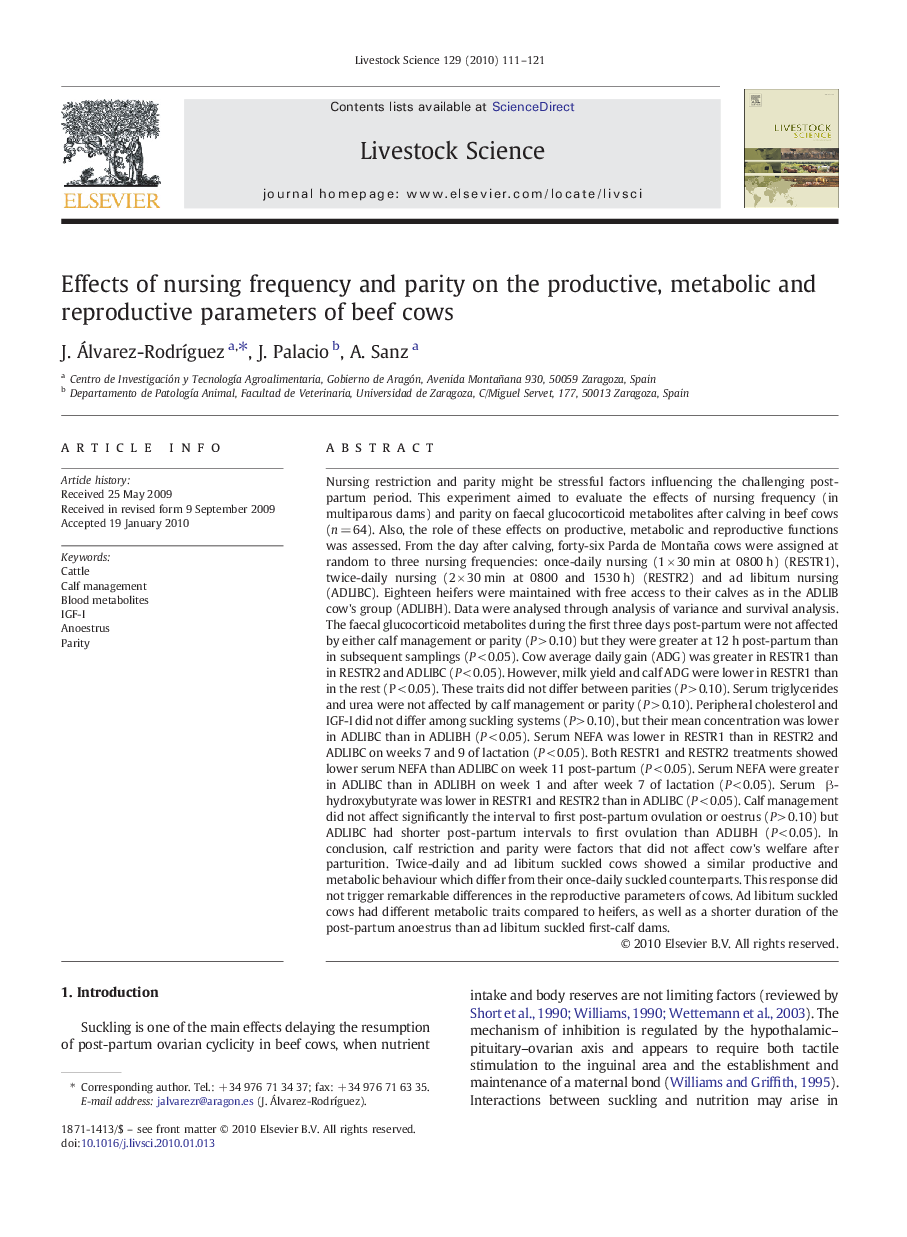| کد مقاله | کد نشریه | سال انتشار | مقاله انگلیسی | نسخه تمام متن |
|---|---|---|---|---|
| 2448008 | 1554003 | 2010 | 11 صفحه PDF | دانلود رایگان |

Nursing restriction and parity might be stressful factors influencing the challenging post-partum period. This experiment aimed to evaluate the effects of nursing frequency (in multiparous dams) and parity on faecal glucocorticoid metabolites after calving in beef cows (n = 64). Also, the role of these effects on productive, metabolic and reproductive functions was assessed. From the day after calving, forty-six Parda de Montaña cows were assigned at random to three nursing frequencies: once-daily nursing (1 × 30 min at 0800 h) (RESTR1), twice-daily nursing (2 × 30 min at 0800 and 1530 h) (RESTR2) and ad libitum nursing (ADLIBC). Eighteen heifers were maintained with free access to their calves as in the ADLIB cow's group (ADLIBH). Data were analysed through analysis of variance and survival analysis.The faecal glucocorticoid metabolites during the first three days post-partum were not affected by either calf management or parity (P > 0.10) but they were greater at 12 h post-partum than in subsequent samplings (P < 0.05). Cow average daily gain (ADG) was greater in RESTR1 than in RESTR2 and ADLIBC (P < 0.05). However, milk yield and calf ADG were lower in RESTR1 than in the rest (P < 0.05). These traits did not differ between parities (P > 0.10). Serum triglycerides and urea were not affected by calf management or parity (P > 0.10). Peripheral cholesterol and IGF-I did not differ among suckling systems (P > 0.10), but their mean concentration was lower in ADLIBC than in ADLIBH (P < 0.05). Serum NEFA was lower in RESTR1 than in RESTR2 and ADLIBC on weeks 7 and 9 of lactation (P < 0.05). Both RESTR1 and RESTR2 treatments showed lower serum NEFA than ADLIBC on week 11 post-partum (P < 0.05). Serum NEFA were greater in ADLIBC than in ADLIBH on week 1 and after week 7 of lactation (P < 0.05). Serum β-hydroxybutyrate was lower in RESTR1 and RESTR2 than in ADLIBC (P < 0.05). Calf management did not affect significantly the interval to first post-partum ovulation or oestrus (P > 0.10) but ADLIBC had shorter post-partum intervals to first ovulation than ADLIBH (P < 0.05). In conclusion, calf restriction and parity were factors that did not affect cow's welfare after parturition. Twice-daily and ad libitum suckled cows showed a similar productive and metabolic behaviour which differ from their once-daily suckled counterparts. This response did not trigger remarkable differences in the reproductive parameters of cows. Ad libitum suckled cows had different metabolic traits compared to heifers, as well as a shorter duration of the post-partum anoestrus than ad libitum suckled first-calf dams.
Journal: Livestock Science - Volume 129, Issues 1–3, April 2010, Pages 111–121